
Jarrold’s postcard of Hebridean Isles at Lochmaddy is one of the most engaging commercial portraits of a vessel on the Uig triangle since the route became part of the Hebridean ferry network in 1964. ‘Heb Isles’ operated there from 1986 until the current Hebrides entered service in 2001
John Park views the Uig triangle through the prism of picture postcards which have documented the route’s development over the past half century.
Before the inauguration of a car ferry service linking Uig, Tarbert (Harris) and Lochmaddy in 1964, there were very few colour postcards of MacBrayne ships at any of the triangle piers. Lochmor and Loch Ard both appear in early 1960s colour postcards of Tarbert, and Lochmor also features in a Lochmaddy card but, a decade after the early 1950s proliferation of colour photography, there seems to have been a limited choice of picture postcards featuring MacBrayne ships at Hebridean ports.
That began to change as the west coast of Scotland opened up to the motor car. The tourist market expanded rapidly in the mid-to-late 1960s, and postcard publishers were keen to keep their range of cards up-to-date: changes to a local scene would often result in a photographer being despatched to the location, with an updated view soon replacing the previous out-of-date scene. A new ferry was a common reason for updating postcard views, and this proved to be the case at Uig, Tarbert and Lochmaddy.
Not all major card publishers covered the Scottish islands, but the inauguration of the Uig triangle service by Hebrides in 1964 prompted several to issue a range of new cards soon after her arrival.
Valentines of Dundee had been publishing picture postcards since the mid 19th century and by the 1960s were producing distinctive deckle-edged cards. They published a ‘Ferries to the Hebrides’ multi-view postcard in this style, a card clearly inspired by the new MacBrayne car ferry services.
The four miniature views on this card, two of Clansman on the Mallaig-Armadale service and two of Hebrides on the triangle, were also published as full sized postcards, with the view of Hebrides at Tarbert the most attractive of the series. Sadly, these proved to be among the last cards issued by this famous company, which ceased all postcard production in 1970.
Some of the best-known cards of this period came from the Isle of Wight-based firm of J. Arthur Dixon. Having established themselves on MacBrayne territory in the late 1950s/early 1960s with atmospheric colour postcards of King George V at Iona, Lochnevis at Portree and Loch Seaforth at Stornoway, this firm continued to produce a wide range of attractive cards, adding several early views of Hebrides on the new route to their range.
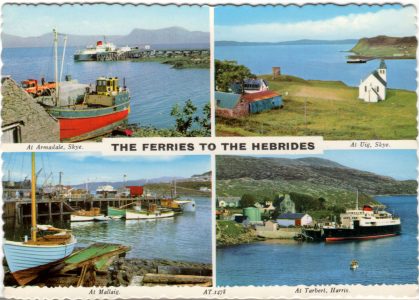
Valentines’ mid 1960s multi-view postcard was clearly inspired by the new MacBrayne car ferry services
They issued at least three different postcards of her at Tarbert, plus a timeless view of her approaching Uig in low evening sunshine — an outstanding card which continued in production for many years.
The White Heather Publishing company of Aberdeen also produced postcards of Hebrides during this early period, the highlight being a morning view of her arrival at Uig with a MacBraynes bus on the pier awaiting connecting passengers. That picture summed up MacBraynes’ integrated transport system at its best, long before anyone had thought up such terminology.
Among other postcards in circulation during this early period was a Colourmaster card of Hebrides at Uig. In general Lochmaddy cards seem to be less common than Uig and Tarbert, probably reflecting the fact that there are fewer accessible vantage points for photography at the North Uist port than elsewhere on the triangle.
Further postcards of Hebrides were published during the 1970s after her appearance in CalMac colours. A well trained eye may spot the buff mast and lion emblems on her funnel, demonstrating just how keen postcard publishers were to keep their ranges up-to-date. J. Arthur Dixon updated their views of Hebrides at Uig and Tarbert, while Jarrold & Sons of Norwich published a distinctive view of her turning within the narrow confines of the loch at Tarbert. Another notable card issued during this period was an aerial view of Hebrides at Lochmaddy by the lesser known Larkfield Printing Company of Brighouse.
The arrival of Hebridean Isles on the route in 1986 prompted a new range of postcards. The size and style of picture postcards had changed by this time, with many cards now being produced in a larger size format which often featured a white border and greeting on the front. New publisher names were also beginning to replace some of the old familiar brand names.
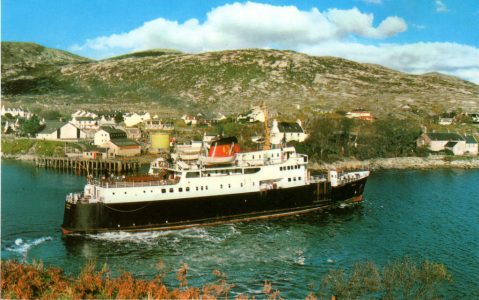
In the early CalMac era (post 1973) Jarrold & Sons of Norwich published a distinctive view of Hebrides turning in the confines of the loch at Tarbert
Long-established publishers J. Arthur Dixon and Jarrold were still around, and both updated their ranges by featuring the new Hebridean Isles in a selection of local views around the triangle. Jarrolds also published a card of the paddle steamer Waverley making her first and only visit to Tarbert in early May 1989.
Among the newcomers who published postcards during the ‘Heb Isles’ era were Sue Anderson Photography, Phil Banks Photography and Stirling Gallery of Edinburgh, all of whom managed to capture Hebridean Isles at some or all of the triangle ports. A small number of postcards were also specially produced for local businesses by other publishers such as Nevisprint of Fort William.
Postcards from the Hebridean Isles era seem in general to feature wider scenic views rather than close-up views of the ferry. However, some closer views were still in circulation. A Sue Anderson card of Hebridean Isles arriving at Tarbert and a Jarrold card of her turning at Lochmaddy are probably the pick from this period. As before, there seem to have been fewer postcards available from the Lochmaddy area than from Uig and Tarbert.
After the current Hebrides replaced Hebridean Isles in 2001, a further new range of postcards began to appear. Card styles generally continued in the larger size, but some publishers stuck with the more traditional borderless format preferred by most collectors.
Sue Anderson Photography and Mull-based Island Blue Series published some attractive traditional cards illustrating the new Hebrides at the triangle ports, with a welcome return to the ferry being the main feature of the views.
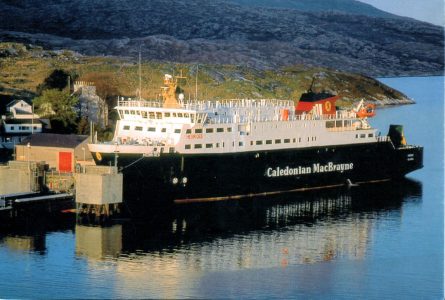
A Sue Anderson postcard of the present Hebrides at Tarbert. Ferry design has moved on since 1964. So has the style of the pier
The best of these just now are an Island Series card with an elevated view of Hebrides approaching Uig on a very calm Loch Snizort, and a Sue Anderson card at Tarbert taken from almost the exact same position as the 1960s Valentines card of the previous Hebrides. The two Tarbert cards, issued some 40 years apart, make an interesting comparison in both ferry and postcard styles, with both designs now looking remarkably dated.
Deltiology, the official title for the study and collection of postcards, can be a subjective hobby and readers may well have their own favourite cards from each period of the triangle service. It is also likely they will have cards in their own collection which are not mentioned here. One of the fascinating aspects of postcard collecting is that there are no definitive lists of cards to collect, and the discovery of a previously unknown card which fits a particular theme is the most rewarding experience for any collector.
Whether picture postcards will continue to document the changing ferry landscape is anyone’s guess. Thanks to the instant sharing of holiday experiences by digital technology, the demand for postcards may be in decline. Whatever the case, it is hard to imagine the next half-century of the triangle producing the same varied range of postcards as the first.
If you have a collection of postcards illustrating the history of a particular route, and would like to write about it, please email info@crsc.org.uk

J. Arthur Dixon’s early 1960s postcard showing the MacBrayne cargo ship Loch Ard at Tarbert captures island life before the motor car took over
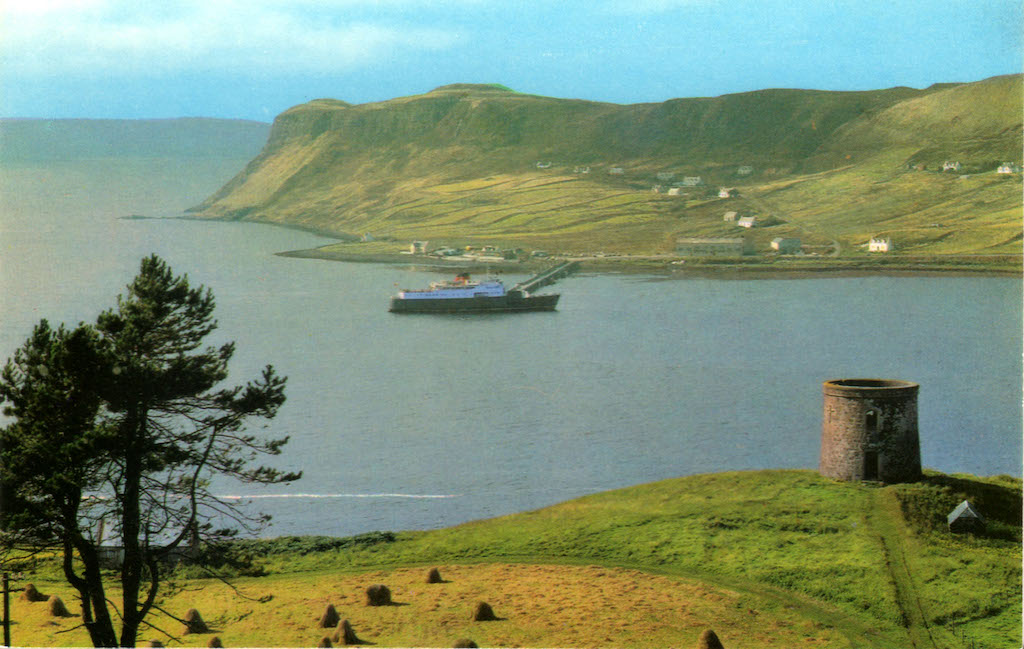
This Colourmaster view of the 1964 Hebrides at Uig placed the ferry in the context of the wider Hebridean landscape

One of the most atmospheric postcards of the early car ferry period was White Heather’s morning view of Hebrides arriving at Uig, with a bus waiting on the pier. That picture summed up MacBraynes’ integrated transport system at its best

Timeless: most ferry nutters would be proud to have taken a photo as well-proportioned as J. Arthur Dixon’s postcard view of Hebrides approaching Uig in the late 1960s, showing off the vessel’s beautiful lines
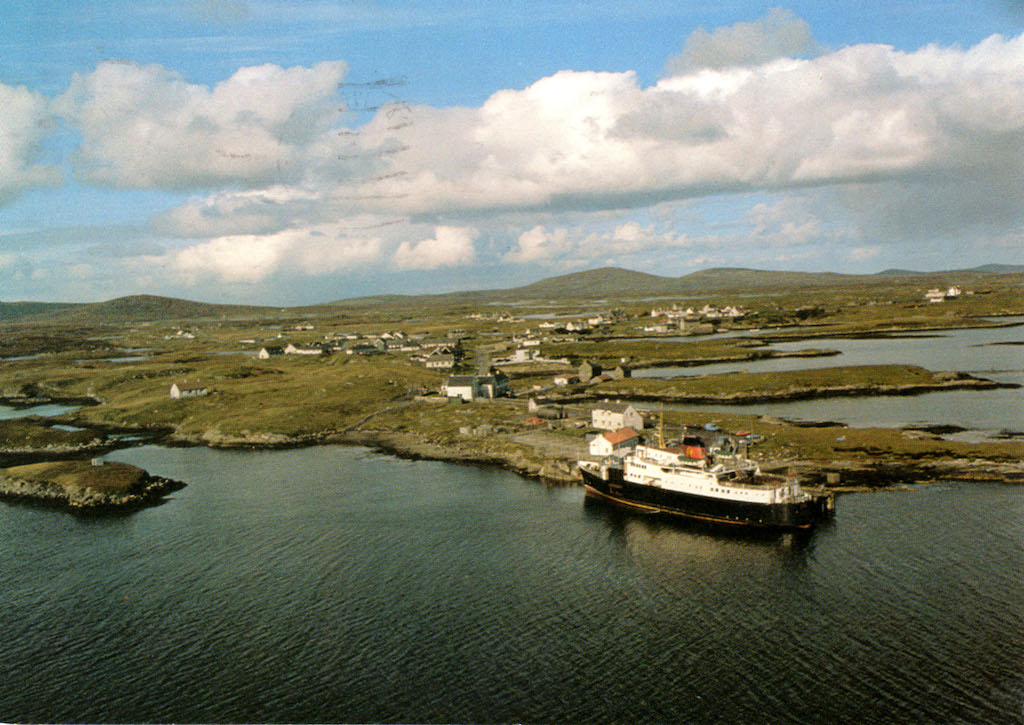
This Larkfield view of the 1964 Hebrides at Lochmaddy captured the ferry from an unusual angle and also profiled the Uist landscape

The hill from which the previous view was taken now forms a strong backdrop for this postcard from the late 80s/early 90s, showing Hebridean Isles’ arrival at Lochmaddy. The card was produced by Nevisprint for MacGillivray’s Crafts of Benbecula

A Stirling postcard from around the same time captures Hebridean Isles at Uig in what must surely count as one of the most attractive picture portraits from the triangle. A summer haze casts a beatific air over a scene embracing movement and stillness
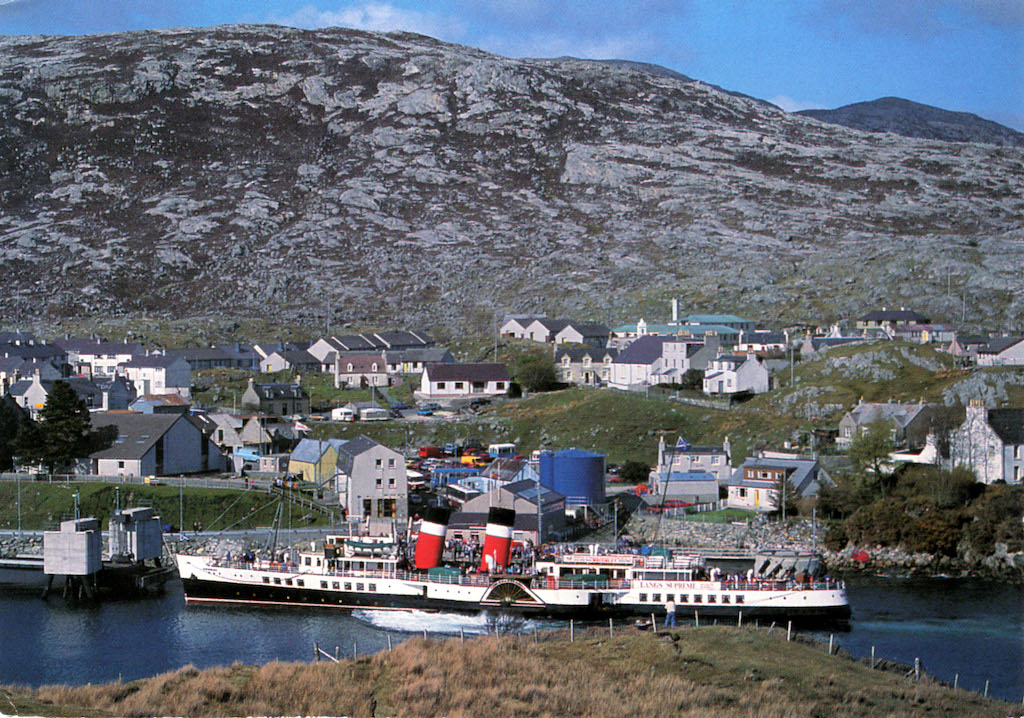
The only year in which Waverley visited Harris was 1989, a scene captured in a Jarrold postcard that probably meant more to steamer enthusiasts than it did to islanders or summer tourists

Bathed in sun, Hebrides at Uig is one of the best postcards produced in the Mull-based Island Blue Series

Sue Anderson Photography’s postcard of Hebrides at Lochmaddy has more light on the background than on the ferry

‘Having a lovely time, wish you were here’: the age-old postcard cliché holds good here in a Sue Anderson portrait of Hebrides that shows both ship and photographer at their best
PREVIOUS POSTS BY JOHN PARK:
Battling a southerly swell in Millport Bay (2020)
King George V’s last public cruise (2020)
How about joining CRSC? You can do so for just £10 by clicking here — and you’ll receive all the benefits, including annual Review of west coast ship movements, 54-page colour magazine, discounts on photo offers and access to photo-rich ‘members only’ posts.
Published on 1 November 2020












